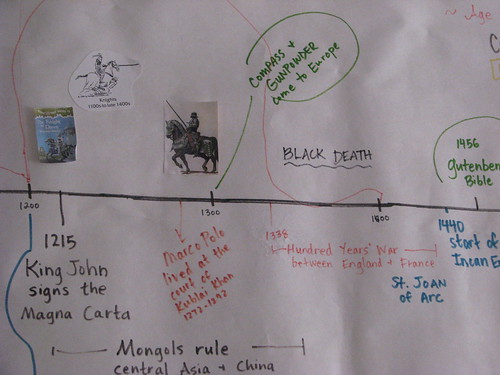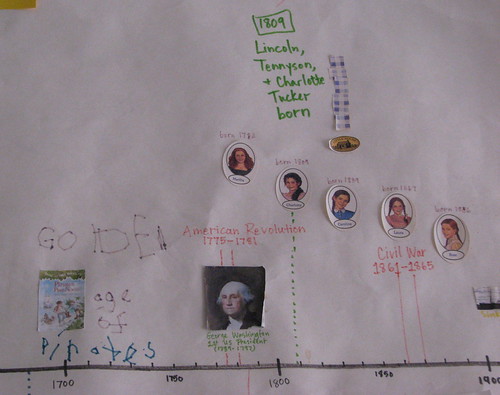I've written about this before, but it requires reinforcement.
I hate it when a writer doesn't know the difference between writing in present and past tense (I like both if done correctly). Lately I've picked up several books that have both tenses in the same paragraph, sometimes the same sentence. Those books quickly end up on my discard pile even if I genuinely enjoyed the premise. I can forgive one or two lapses, but not an entire book.
Viewing: Blog Posts Tagged with: Timeline, Most Recent at Top [Help]
Results 26 - 34 of 34
Blog: Game On! Creating Character Conflict (Login to Add to MyJacketFlap)
JacketFlap tags: editing, writing, future, proofreading, present, timeline, past, plot holes, verb tense, Add a tag
Blog: Darcy Pattison's Revision Notes (Login to Add to MyJacketFlap)
JacketFlap tags: fiction, novel, character, word, timeline, copyedit, edit, consistency, logic, novel revision, phrase, Add a tag
Goodreads Book Giveaway
Start Your Novel
by Darcy Pattison
Giveaway ends October 01, 2013.
See the giveaway details at Goodreads.
In this January 6, 2013 NPR interview, John Sandys talks about inconsistencies in movies that were released in 2012:
Well, I think ’cause “Men in Black 3″ travels back and forth in time, it means you’ve got a whole host of factual mistakes as well, which it opens itself up to. One which jumped at me was in Cape Canaveral in 1969, we see the flag of Spain waving, but it’s the wrong flag. It’s the current era flag, not the 1969-era flag. I mean, it’s hardly a major research job. I don’t know whether they thought it wasn’t worth looking into or they just thought, well, no one will care.
This week, I am doing a final pass through of a novel and finding tons of inconsistencies.
For example, the main character shows up in a cloak and a scarf wrapped around her head. But at the beginning of the next scene, which is a direct follow-up, she throws back her hood and takes off her cloak. In another scene, she is described as wearing a cape.
(I know: Capes are soooo out of style.)
Reading and revising for consistency of details is different than reading for story. Here are a few tips:
- Put on your editor’s hat. This isn’t the time to worry about the story line, characterization, plot or those other big issues. Instead, you need to be very logical and you need to pay attention. That requires a different mindset.
- Take notes. I use sticky notes, but you could use just a sheet of paper to jot notes. As I read along, I jot down anything that sounds fishy to me, or I am uncertain of consistency through out the manuscript: numbers, names, eye color, hair color, peculiar or unusual wordings, etc. For complicated books or series, some suggest a Story Bible, or a place where you record all such details. For this story, I didn’t feel the need for something that structured. But in an upcoming series, I will definitely go that route.
- Timeline. Lots of what I am doing this week is tightening the time line. I had to cut some scenes and that left my character at a loss for an afternoon and evening. So, I moved some scenes to fill in those spaces. Often, I will literally fill in a calendar for the final timeline (after the major revisions), and often it will be hour by hour. I know I planned it all out before, but the revisions make a difference. So, I do it again.
- Words and phrases. I also make sure I haven’t repeated a word or phrase too often. It’s hard to describe how this one works, but you sorta have a watcher in your head paying attention to how a story is told. And it will go, “Whoa! Stop right there, little missy.” So, I stop and correct. It’s paying attention to the difference between work table and workbench.
- Logic. It’s important for every action to be in the correct time order and to be logical. Clarity rules on this pass through. You can’t hit a ball with a bat if you haven’t picked up a bat first.
Of course, I am making these types of decisions as I write the manuscript, but I’ve found I need one last run through. What else do you check for in your last pass through a manuscript?
Blog: Darcy Pattison's Revision Notes (Login to Add to MyJacketFlap)
JacketFlap tags: novel, plot, pacing, timeline, flashbacks, Add a tag
START YOUR NOVEL
Six Winning Steps Toward a Compelling Opening Line, Scene and Chapter- 29 Plot Templates
- 2 Essential Writing Skills
- 100 Examples of Opening Lines
- 7 Weak Openings to Avoid
- 4 Strong Openings to Use
- 3 Assignments to Get Unstuck
- 7 Problems to Resolve
When you are deep into plotting a new novel or especially, a series, timelines are your friends. It’s a tool that will help straighten out the details and create order.
Obviously, a time line lays out the time period of your novel. Does it take place in 24 hours or does it span 24 years? Within that time span, you’ll want to slot events, reactions, and characters.
Backstory. Using a time line to plan a story probably means you’ll want to include back story events. You can do as much or as little as you need here. Maybe you want to include a character’s birth, baptism or bar mitzvah, high school graduation, or other major life events. You’ll also want to include other major events: parent’s divorce, house burned down, moving to a new school or city, first job and so on.
You can choose to do a separate time line for each person, but I like to have a master timeline where each character’s events are included. If you like, you can get fancy with this and do it on a spread sheet with each character getting a column or a certain color row.
Plot Events. When the events reach the story’s opening, it’s time to start imposing some structure. Dividing the time line into Act 1, 2 and 3 (and 4, if you use that paradigm), makes sense. You’ll want to make sure the story’s time line provides characters a great stage entrance, then introduces events that keep the story rolling. Here’s a great place to start tweaking the pacing of your story.

Ticking Clocks. Speaking of pacing, try introducing a ticking clock: some event must be completed by midnight or unspeakably bad things will happen. If Sherlock Holmes doesn’t solve the crime by midnight, beautiful Aurelia will be the victim of Poe’s pendulum (to mix up a lot of things!).
Edit and Revise. This is also a place where you should edit drastically. If you think up a scene, but can’t decide where to put it–cut it. It’s probably not important to the story anyway. Each scene or event should serve a definite purpose that pulls the reader toward the climactic ending. Some events will have a quiet purpose like characterization or setting p the next scene. OK, as long as there’s some purpose to the scene. Time enough later to Kill-Your- Darlings when you revise the novel.
Messing with the TimeLine. Now that you have the time line laid out, you can actually mess with it, if you like. You could present scenes out of order, with back story coming in as a flashback or even more drastic manipulations of time. The movie, Memento, is about a character with a short term memory problem, which lead to strange time manipulations. If you want to do this, be warned: the younger the audience, the more likely you are to confuse them. Telling a story with a jumbled timeline makes it harder for your reader to understand and enjoy. So, if you decide to go this route, use your best storytelling techniques. Read about flashbacks here or here.
Blog: Ypulse (Login to Add to MyJacketFlap)
JacketFlap tags: nostalgia, Timeline, jimmy kimmel, economy, Millennials, Ypulse Essentials, will smith, simon cowell, 90s, Election 2012, 2012 trends, Star Wars Episode 1: The Phantom Menance, What Matters Most Campaign, Blogging, teenagers, fame, facebook, Add a tag
 What matters most to young people in the 2012 election? (Facebook is calculating this in its new campaign “What Matters Most” where users rank the top three issues that are most important to them and their picture and thoughts can be featured on... Read the rest of this post
What matters most to young people in the 2012 election? (Facebook is calculating this in its new campaign “What Matters Most” where users rank the top three issues that are most important to them and their picture and thoughts can be featured on... Read the rest of this post
Blog: Darcy Pattison's Revision Notes (Login to Add to MyJacketFlap)
JacketFlap tags: faegen, authors, plot, fast forward, pacing, timeline, show don't tell, trinity, Add a tag
Random Acts of Publicity DISCOUNT:

$10 OFF The Book Trailer Manual.
Use discount code: RAP2011
http://booktrailermanual.com/manual
Debut Novel: Spreadsheets Used for Plotting and Revising a Novel
Introduced first in 2007, debut children’s authors have formed a cooperative effort to market their books. I featured Revision Stories from the Classes of 2k8 and 2k9 and this feature returns this year with the Class of 2k11.

Trinity Faegen, THE MEPHISTO COVENANT, YA, Fall 2011
Revisions: Literary Fast Forward
Guest post by Trinity Faegen
Ironically, I’m writing this just after receiving the editorial letter and line edits on my first YA novel. The editor has an issue with my timeline and asked me to extend it.
How long is your story from beginning to end? A day? A week? A year? Mine is about a week, and he feels this is too short, that I need to extend it to ten days or even two weeks, but how can I lengthen the timeline without adding extraneous scenes that read like filler?
The answer is the literary equivalent of fast forward.
First, I’ll find one or more areas within the manuscript that are already transitional, such as the end of a scene that draws a subplot to conclusion, or one that ends a dramatic confrontation. I’m fortunate because one of my plot elements involves a character’s need for information, which can’t be had quickly. I will find a scene ending that lends itself to a lapse of dramatic action until things begin to happen again. I’ll add a few paragraphs to the beginning of the next scene, in the appropriate point of view, to let the reader know time has passed, but nothing happened off-screen. The characters ate, slept, went to school, lived their lives, until now, when we are picking up the pace again.
The paragraphs might read something like this:
“After her miserable first day at Telluride High, Sasha didn’t think it could get worse. She was wrong. As the lie Brett told about her spread, it morphed into something even he, in his twisted, pervy little mind, couldn’t have dreamed up. Not only did everyone believe she had sex on the Internet, they now thought she did it for money. She was like a leper, always alone, everyone avoiding her as if she was contagious.
Add a Comment
By Friday, her fifth day in Hell, she’d had enough. Somehow, she had to turn the tables on Brett, and since she had not one single friend to help, she’d have to do it alone.
First period began like always, Mrs. Redmon calling on another victim to read from The Metamorphosis. Sasha could feel Brett’s eyes staring at her, knew he was smirking, smug and pleased with him
Blog: Here in the Bonny Glen (Login to Add to MyJacketFlap)
JacketFlap tags: History, Fun Learning Stuff, timeline, Add a tag
Got lots of requests to post photos of the timeline. Here you go, but I must point out that you didn’t specify *good* photos.
We began this timeline when Jane was about six years old. She was on a major Magic Tree House kick that year, and she got super excited by the idea of printing out little images of the book covers and gluing them onto a timeline. (Glueing? My spellcheck says no, but it looks better to me that way. Whatevs.)
I bought a roll of art paper and tacked it to the hall wall. The length of the timeline was determined in the following scientific manner: when I got to the end of the hall, I cut the paper. I drew a mostly straight line along the middle with a Sharpie. Then I measured the line (this is such a backwards way to approach it) and figured out how many centuries I wanted to include, and divided it up more or less evenly. I probably hollered down the hall to get Scott to do the math for me, because I can’t hold a ruler and divide at the same time.
Yikes, the fold-wrinkles really look awful in this picture, don’t they? They don’t show up that way in real life. I suppose it’s in pretty good shape considering it spent the last four years rolled up and semi-smashed under a poster tube. Why it wasn’t inside the poster tube, I cannot say.
I think if you click on the pic you’ll go to Flickr where you can see a larger image. And you’ll see it’s nothing fancy. The yellow tags at the top say ANCIENT HISTORY, DARK AGES, MIDDLE AGES, MODERN TIMES. These are, of course, rough divisions.
A few closeups. We began, as I said, with the time periods Jack and Annie visited in the MTH books. (Over the years, most of those pasted-on book covers have fallen off.) Later, we gradually filled in other events we read about. Sometimes we printed out pictures to help us remember, like the little illuminated manuscript we glued on probably six or seven years ago. It was fun to discover it again yesterday, just minutes after we’d clicked all over the internet looking at illuminations.
Look! One of the Magic Tree House covers survived!
This is my favorite section because it’s got so much of wee Jane in it. That wobbly six-year-old’s handwriting spelling out “Golden Age of Pirates,” couldn’t you just die? So sweet. The pirates’ heyday was hugely important to her, back then.
And the Little House girls. She had me cut them out and show her where to stick them on. She herself cut the blue gingham border and Little House logo off a notepad my editor had sent me; these were vital decorations, you understand.
It’s funny now to look back and think of all those books we read together, Child’s History of the World and whatnot, when she was So. Very. Young. We continued to add to the timeline after our move to Virginia in early 2002, but in that house it was up high on a wall over the piano and after a while I got tired of climbing on a stool to reach it, and we stopp
Add a CommentBlog: Bookfinder.com Journal (Login to Add to MyJacketFlap)
JacketFlap tags: history, book, Websites of Interest, timeline, Add a tag
Blog: Scribbled Business (Login to Add to MyJacketFlap)
JacketFlap tags: free, evolution, sketchbooks, blog contest, looking back, retrospective, timeline, drawings by children, free, sketchbooks, evolution, blog contest, retrospective, looking back, timeline, drawings by children, Add a tag
I spent a bit of today looking through old sketchbooks and had a good laugh. Take a look at a sketch I completed in 1989: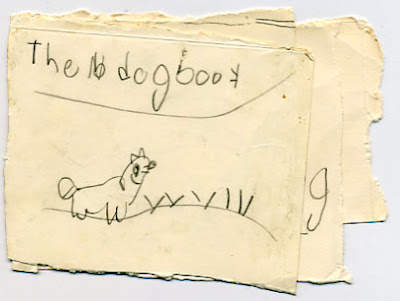
From 1997: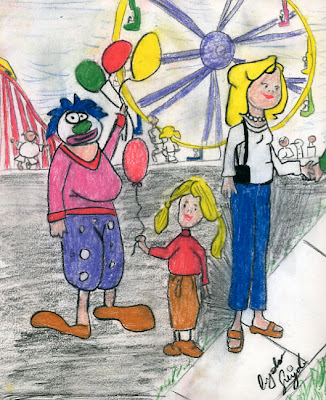
And some from 2002 (I was a student at Grant MacEwan College):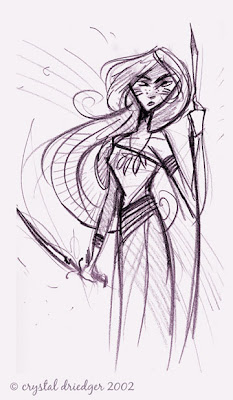
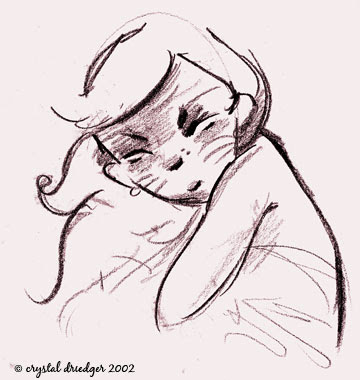
Evolution is a wonderful thing!
*there's only one more day until my blog contest ends! Scroll down for more information.
Blog: Neil Gaiman (Login to Add to MyJacketFlap)
JacketFlap tags: hungarian signing, guest posting on my own blog, Black Phoenix Alchemy and Scents, lisa snellings, hy bender, Add a tag
I feel -- this is Neil -- like I'm making a guest post on my own Blog. (I'm loving what Maddy's doing. Makes me feel quite inadequate as a blogger.) Anyway. Just nipping in to say that I'm going to be doing a semi-informal signing on my last night in Budapest.
I'll be at Sárkánytűz, 1092 Ferenc Krt. 40, on Wednesday July 4th at 7.00pm. I know it's not much warning, but it's really something we set up because I keep getting lots of wistful messages from Hungarian readers who have noticed I'm in Budapest and hope that I could be persuaded to do something. If you're around, turn up and I'll cheerfully scribble on things and answer questions and so on.
Store details at http://www.sarkanytuz.hu/index.php?base=shops&id=10 (And I was thrilled to discover that there's a Good Fantasy and Cool Literature website at http://endless.hu/).
And while I'm here I'll quickly put up a link to http://www.comicon.com/ubb/ultimatebb.php/ubb/get_topic/f/36/t/006422.html which is Kate Keller's offer to match donations to the CBLDF (who need funds for the Gordon Lee case -- http://www.cbldf.org/pr/archives/000314.shtml for details.)
Lisa Snellings is making little blue poppets and donating a dollar to the CBLDF for every one sold.
(She also mentions that Hy Bender, whom you probably know best as the author of The Sandman Companion, will give you expert advice through his websites Hy On Your Book and Hy On your Script. He will analyze your project with humor and clarity to rival any Dummies Books (of which he's written five.) He tells me that the word "Poppet" in your email will get you an extremely reduced price for his services. Hy Bender tends to be partial to Poppets, which could work out well for writers who are too. Check it out, forward it to your writer groups. Thanks, Hy! I'm hoping we can also get the Sandman Companion updated in time for Sandman's 20th anniversary...)
Over at Black Phoenix they've launched more scents -- the Good Omens ones and the Stardust ones. Like the Neil Gaiman ones, the profits go to the CBLDF (and to the Orang Utan Foundation charity).
And a small, painful postscript to something I talked about already on the blog. This letter came in from Maureen Johnson.
Hi Neil,
A few weeks ago, you were kind enough to link to a post on my blog. My book had been banned in a school in Oklahoma, and I was fighting it. With your help, dozens (maybe even a hundred or more) letters were sent to the committee that did the deed. (The day you linked to me, the hits went through the roof.)
What happened next was ridiculous. I spent weeks on the inside track of this small town, getting calls from neighbors, newspaper reporters, and all kinds of people involved and around. We also (with the help of a local reporter) caught them violating policy by banning a book without notifying the public. At one point, they even claimed the whole thing never happened. The letters did have an impact, though. They had to reconsider, and do it publicly. They hated the spotlight.
Well, this committee of geniuses has finally come to a decision. They haven’t banned my book—but they’ve put it on a special reserve shelf. It can only be checked out “for classroom purposes” with a signed note from a parent.
This is arguably the most asinine thing I've ever heard.
This is a book that contains no graphic material at all. This is purely because it has homosexual characters. And from what I can tell, they plan on implementing a policy by which they have parents troop through the library once a year, just in case there are other books they want put on the naughty shelf.
On top of that, they demoted the librarian who was on the committee (Kim), the one who told us what really happened in the meeting where the book was banned. They also made life miserable for main school librarian involved (Susan), the one who came to me for help. Rather than suck up to these people, Susan decided to resign after 30 years at her job. She said she was happy to go down doing what she thought was right. So two librarians took a hit in this, simply because they tried to protect the books on their shelves.
It’s disgusting and insane, but that’s the outcome. In any case, it’s been amazing to see how many people are outraged by this, and willing to do something about it. Your post made a huge difference in terms of getting the word out. I’ll probably go on trying to needle these idiots for a while yet. I can at least try to shame them some more.
Thanks again,
-Maureen Johnson
(And here's Maureen's blogpost about the final decision.)








